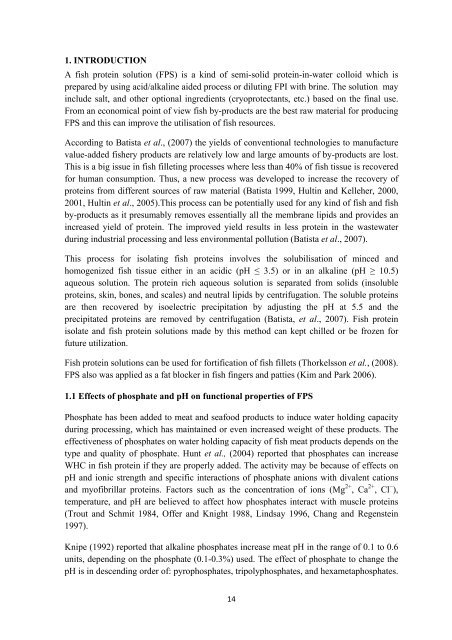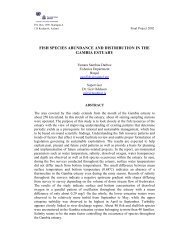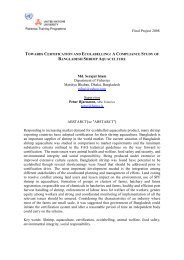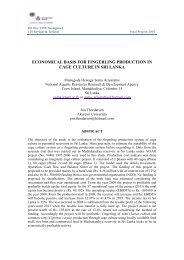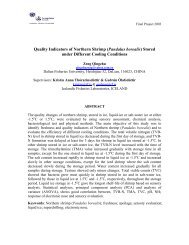Evaluation and Utilisation of Fish Protein Isolate Products
Evaluation and Utilisation of Fish Protein Isolate Products
Evaluation and Utilisation of Fish Protein Isolate Products
- No tags were found...
You also want an ePaper? Increase the reach of your titles
YUMPU automatically turns print PDFs into web optimized ePapers that Google loves.
1. INTRODUCTIONA fish protein solution (FPS) is a kind <strong>of</strong> semi-solid protein-in-water colloid which isprepared by using acid/alkaline aided process or diluting FPI with brine. The solution mayinclude salt, <strong>and</strong> other optional ingredients (cryoprotectants, etc.) based on the final use.From an economical point <strong>of</strong> view fish by-products are the best raw material for producingFPS <strong>and</strong> this can improve the utilisation <strong>of</strong> fish resources.According to Batista et al., (2007) the yields <strong>of</strong> conventional technologies to manufacturevalue-added fishery products are relatively low <strong>and</strong> large amounts <strong>of</strong> by-products are lost.This is a big issue in fish filleting processes where less than 40% <strong>of</strong> fish tissue is recoveredfor human consumption. Thus, a new process was developed to increase the recovery <strong>of</strong>proteins from different sources <strong>of</strong> raw material (Batista 1999, Hultin <strong>and</strong> Kelleher, 2000,2001, Hultin et al., 2005).This process can be potentially used for any kind <strong>of</strong> fish <strong>and</strong> fishby-products as it presumably removes essentially all the membrane lipids <strong>and</strong> provides anincreased yield <strong>of</strong> protein. The improved yield results in less protein in the wastewaterduring industrial processing <strong>and</strong> less environmental pollution (Batista et al., 2007).This process for isolating fish proteins involves the solubilisation <strong>of</strong> minced <strong>and</strong>homogenized fish tissue either in an acidic (pH ≤ 3.5) or in an alkaline (pH ≥ 10.5)aqueous solution. The protein rich aqueous solution is separated from solids (insolubleproteins, skin, bones, <strong>and</strong> scales) <strong>and</strong> neutral lipids by centrifugation. The soluble proteinsare then recovered by isoelectric precipitation by adjusting the pH at 5.5 <strong>and</strong> theprecipitated proteins are removed by centrifugation (Batista, et al., 2007). <strong>Fish</strong> proteinisolate <strong>and</strong> fish protein solutions made by this method can kept chilled or be frozen forfuture utilization.<strong>Fish</strong> protein solutions can be used for fortification <strong>of</strong> fish fillets (Thorkelsson et al., (2008).FPS also was applied as a fat blocker in fish fingers <strong>and</strong> patties (Kim <strong>and</strong> Park 2006).1.1 Effects <strong>of</strong> phosphate <strong>and</strong> pH on functional properties <strong>of</strong> FPSPhosphate has been added to meat <strong>and</strong> seafood products to induce water holding capacityduring processing, which has maintained or even increased weight <strong>of</strong> these products. Theeffectiveness <strong>of</strong> phosphates on water holding capacity <strong>of</strong> fish meat products depends on thetype <strong>and</strong> quality <strong>of</strong> phosphate. Hunt et al., (2004) reported that phosphates can increaseWHC in fish protein if they are properly added. The activity may be because <strong>of</strong> effects onpH <strong>and</strong> ionic strength <strong>and</strong> specific interactions <strong>of</strong> phosphate anions with divalent cations<strong>and</strong> my<strong>of</strong>ibrillar proteins. Factors such as the concentration <strong>of</strong> ions (Mg 2+ , Ca 2+ , Cl − ),temperature, <strong>and</strong> pH are believed to affect how phosphates interact with muscle proteins(Trout <strong>and</strong> Schmit 1984, Offer <strong>and</strong> Knight 1988, Lindsay 1996, Chang <strong>and</strong> Regenstein1997).Knipe (1992) reported that alkaline phosphates increase meat pH in the range <strong>of</strong> 0.1 to 0.6units, depending on the phosphate (0.1-0.3%) used. The effect <strong>of</strong> phosphate to change thepH is in descending order <strong>of</strong>: pyrophosphates, tripolyphosphates, <strong>and</strong> hexametaphosphates.14


